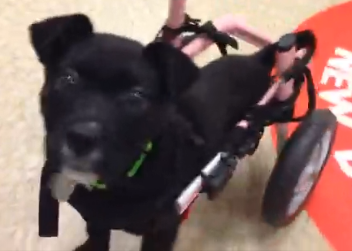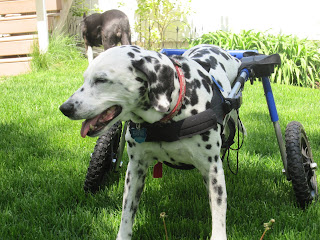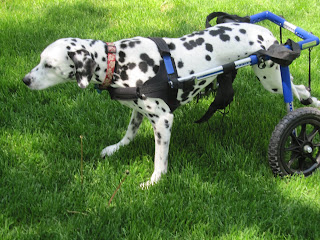The Dog Wheelchair Review had the opportunity to interview Mark C. Robinson, inventor of the Walkin’ Wheels adjustable dog wheelchair.
DWR: So Mark, your invention has moved the dog wheelchair industry to a new level. Where did you get started with the idea?
MCR: Many years ago, at a veterinarian’s advice and before the advent of the internet, I put a dog to sleep before her time. My Keeshond, Mercedes, was diagnosed with Canine Epilepsy. I was told it was incurable and the attacks would reoccur and probably increase in intensity. About 10 years ago, once the internet became popular, a dear friend was diagnosed with Epilepsy. With the research I did online, I realized that it was very treatable for my friend, and would have been treatable for my dog. I started the site as an information source and a discussion forum.
DWR: is the “Help and Advice” section at
HandicappedPets.net?
MCR: Yes, it has become the most popular forum of its kind with over 70,000 messages – people helping others care for their handicapped pets. It’s run by a team of volunteers led by CarolC; an amazing group that keeps the forum clean, healthy, and on track.
DWR: So at first, the HandicappedPets.com website was a forum?
MCR: Yes, but soon I added some products to the site to help me cover the costs.
DWR: Like dog wheelchairs?
MCR: No, not yet. They were mostly slings and harnesses from Cathy Erwin of Walkabout Harnesses. Dog wheelchairs didn’t come in until a year or so later. There were so many questions about dog wheelchairs on the forum so I did some research and wrote about them. I did comparative reviews of the custom-made dog wheelchairs from Eddies Wheels, Doggon Wheels, and K9 Carts and took orders for them on the website, making a small sales commission.
DWR: Which dog wheelchair did you like best?
MCR: They all had advantages. Eddies Wheels was brilliantly engineered but, in my opinion, so dog specific as to make it difficult to re-sell. In addition, his 50% up front, non-refundable deposit and return policy of “All Sales Final” was difficult for many dog owners struggling to make ends meet. K9 Carts was well built and very effective, but somewhat cumbersome – often impossible to carry around due to its size. The original owner of K9 Carts, Lincoln Parkes, was the holder of the first patent for a dog wheelchair back in 1983, although his current model is not patented. He and I are the only patent holders. Doggon Wheels was a nice, simple design with flexible harnesses. It was put together, though, with pipe and radiator clamps and looked pretty cobbled-together.
DWR: So how did you come up with your design?
MCR: Basically, I listened very carefully. My customers were all having the same problems:
- Measuring the dog for a custom wheelchair was nearly impossible. A dozen or so measurements were needed and, if done wrong, resulted in a cart that didn’t fit!
- Waiting a week or two for the wheelchair to be built was agony for the dog and the dog owner.
- Return policies were very restrictive. There were cases where the dog suddenly recovered the use of his back legs but the cart couldn’t be returned. Now what?
- They were bulky. They didn’t fold up like wheelchairs for people and you couldn’t take them anywhere.
- They were stiff and inflexible. The frames were all bolts and metal – there was no ‘give’ to them. They were unnatural.
- They looked uncomfortable. In fact they were usually not uncomfortable for the dog, but they sure looked uncomfortable… like small torture devices. Frankly, people would say they were embarrassed to be seen with a dog in a wheelchair because people thought they were doing something awful to the poor creature.
My design solved all these problems. It set out to give handicapped pet owners exactly what they were asking for.
- No measurements are needed – we just need to know the height of the dog so we can snap in the right size wheel into the universal, adjustable frame.
- They can ship same day.
- Reasonable return policy, or the dog wheelchair can be re-sold on Ebay.
- Folds flat to fit in the included tote bag.
- Flexible design. The metal parts are allowed to move and flow with the dog.
- Walkin' Wheels looks great!
DWR: Have they been selling well?
MCR: Yes, I estimate that we sell more dog wheelchairs, US and Internationally, then all the other companies combined. We have retailers throughout the US and distributors in 20 countries around the world.
DWR: I’ve noticed that on one website, Eddies Wheels, there are a number of very disparaging remarks about your product.
MCR: Yes, they are not very nice. For example, we had a corgi in a few months ago that had an odd shape. Our cart didn’t work for him so I told him he needed a custom cart and sent him to Eddies. The “thanks” I got was a scathing editorial suggesting that even
I thought Eddies cart was better than mine. The customer made Eddies take down the article. We all have our disgruntled customers. Eddies has one person, a pet care professional who claims that Eddies Wheels contributed to her dog’s death!
http://thepetpsychic.com/tag/eddies-wheels-hurt-my-dog/
My company policy is to focus on the benefits of our product. I have nothing negative to say about any competitors. We’re all helping the dogs that need us.
DWR: Where are your dog wheelchairs manufactured?
MCR: At first, 100% of our wheelchairs were manufactured in the US. Now about 80% of our carts are made in China. It’s no secret – it says so right on the box. 20% of our carts are made in the US and Canada. Part of the reason our wheelchair is so popular is because it is available in stores and sold by veterinarians and pet care professionals. They need to be able to make a profit when they sell products so they can stay in business. Our goal was to reduce the manufacturing costs so we could get the wheelchair onto the legs of as many dogs as possible. And, the fact is, the 20% we manufacture in the US probably amounts to the same number of wheelchairs that other companies make in the US. The sad fact is that, if we made these wheelchairs in the US, they would be too expensive for cash-strapped pet owners to afford.
DWR: What about people who can’t afford dog wheelchairs?
MCR: I founded, and am on the board of directors for a non-profit called the Handicapped Pets Foundation. This is a 501c3 non-profit that helps people with financial needs to get wheelchairs for their dogs. We’re actively looking for donors and people who want to help promote this organization. Please let your readers know they can go to
http://HPets.org.
DWR: Thanks for being with us today, Mark. Anything else you’d like to say to our readers?
MCR: Thanks! I’d just like to say how grateful I am to the team that’s been responsible for helping the thousands of dogs in Walkin’ Wheels; the staff at HandicappedPets.com, the Message Board Management Team, the engineers, and all the people who write in with comments and ideas to help me make the product better all the time. Please join us and 36,000 fans on the largest handicapped pet community facebook at
http://facebook.com/handicappedpets


















.JPG)





